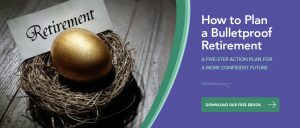Inflation is Here: How to Protect Your Retirement
Working with a registered investment advisor in CT, can help alleviate a rise in blood pressure caused by the recent rise in inflation. While retirees are likely to be some of the most affected, an investment advisor can help you prepare with a retirement strategy that accounts for any crisis often resulting in inflammatory periods.
Before you can make an informed plan on how to protect your retirement, you need to understand what causes inflation to rise, what you might expect in the near future, and how you can take steps to protect your financial future.
Get a second opinion on the finance forecast to make inflation-resilient adjustments to your retirement plan.
What is causing inflation?
In a typical pre-pandemic year, the traditional rate of inflation rises somewhere between one and two percent. That translates into slightly higher prices on regular goods like milk, bread, and eggs, as well as in loan interest rates and worker wages. Slowly rising inflation rates are a sign of a healthy, growing economy.
So what’s causing this past year’s rapid rise in inflation?
In February, Bloomberg reported that January saw the highest jump in consumer prices since 1982 – a rise of 7.5%. Of course, with the Federal Reserve asleep at the wheel and the government flooding Americans with cash, no one should be surprised. As the pandemic enters its third year, there’s also a significant imbalance between supply and demand, a market factor that greatly contributes to inflation.
Consumers with means have changed their spending habits – investing in their homes, vacations, and services that make their lives easier. Global supply chain difficulties paired with a shift from goods-based spending to services spending is likely to evolve this year with additional pressure put on inflation.
Inflation is the #1 threat to retirement.

For retirees, rising inflation can cause significant challenges. For starters, rising inflation lowers the buying power of that hard-earned retirement fund. The fixed income you depend on to maintain your lifestyle through retirement may not last as long as you previously thought. Or perhaps your portfolio hasn’t done as well as you hoped and it’s now time to think about how to recover from financial loss.
In addition to a potentially lower income, rising inflation also means a rise in consumer prices for everyday necessities like groceries, gas and utilities. While retirees may be able to cut some discretionary spending, things like property and income taxes are non-negotiable.
In November, CNBC reported that social security benefits would rise in 2022 thanks to a 5.9% cost-of-living adjustment. Unfortunately, due to the record-high inflation rate and consumer price index – as well as the rising premiums for Medicare – retirees relying on their expected federal income and health insurance benefits may not go as far as they hoped.
While it may be tempting to look at the numbers/forecasting and go into a justifiable panic, it may be more pragmatic to begin planning your retirement with a more optimistic view.
There are some who benefit from an inflationary environment, including those who’ve created a solid investment strategy with their financial advisor. Those with a fixed-rate mortgage benefit from higher inflation because while your asset is appreciating over time, your interest rate is stable. Homeowners actually pay that mortgage with inflated dollars. Stockholders with diversified investment strategies naturally limit exposure to a volatile economy.
Here is what you can do about it.
The best way to make the most of retirement planning is to hover above your financial situation and look at the bigger picture. Long term investing strategies are recommended by credible advisors because they’ve worked for years. If the tried-and-true strategies below aren’t in your plan, you may want to consider changing investment advisors or at least consider speaking with an independent firm that works with high net worth individuals and investors.

Don’t panic
Step 1. Do not panic and make fear-based moves.
Step 2. Stick to the retirement plan you’ve made for yourself with your investment advisor. And whatever you do – don’t make rash decisions when financial markets are under pressure and stress. Time in the markets is the most tried, tested: a true method of maintaining and building wealth. By design, retirement plans can hedge against risk – including market volatility like a rapid rise in inflation.
Align to the future reality
While you shouldn’t be hasty, you may want to pivot. You could capitalize on investments that are positively affected by inflation. Some equities theoretically rise in value proportionally to inflation because their value is based on companies’ product prices. When the company’s profits double, there should be a commensurate rise in the value of that stock.
Diversify your portfolio
A cornerstone to any solid retirement strategy – especially in a changing economic environment – is to diversify your portfolio and strategies. That can include a variety of tools like ETFs which are mostly passively managed. An ETF is an investor-pooled portfolio of stocks (or a fund) that is traded on the exchange as a single stock ticker.
A mutual fund is the same–an investor-pooled portfolio of stocks (or a fund), except that it is actively and passively managed and prices once per day. Both ETFs and mutual funds allow investors to invest in an entire industry and entire economies, instead of single companies. This means if a big company goes bust, your entire portfolio isn’t worthless – just the percentage of the fund that company represents.
Consider investing in commodities
Mature investors often hesitate at trying out new, risky investment strategies as they near retirement, while investors with a higher risk tolerance can win out. Today’s commodities investors are buying ETFs in gold, energy and agriculture .
Look at protected investment options
Another option for diversification is TIPS: treasury inflation-protected securities. These often forgotten securities increase in value with inflation and decrease with deflation. When a TIPS bond matures, investors are paid the highest value of either the adjusted principal or the original principal.
Most notably: TIPS pay interest twice a year at a fixed rate – based on the adjusted principle, so interest payments also rise and fall with inflation and deflation respectively. TIPS exposure can also be bought in ETFs and mutual funds.
Protect your nest egg
Using inflation-protected investment strategies is another effective way to protect your future income. Taxes are likely to rise if inflation continues to rise, making it a smart move to trade in the tax advantaged accounts as soon as possible.
Why? Because your federal income tax rate may never be lower than it is today and you can capitalize on that now instead of paying a higher rate later.
Wait to take social security
While it may not have been in your plan to wait a few extra years to take social security, cutting down on discretionary spending and keeping the budget buttoned up for a little while longer can help protect your financial future. Social security payments are inflation protected, which means if you wait to get your check, that check will be larger and it will also be protected against inflation.
Here’s How You Can Start.
There’s no fool-proof way to fully protect your retirement in any economy. But you can take steps to lower your risk that have worked for other investors over the years.
“Today, you may spend decades in retirement. There’s no margin for error… you need to play defense with your money, not just offense.”
By working with Heritage Capital, LLC. you can utilize high net worth investing strategies in your retirement planning and aim for the healthy financial future you deserve. Call us anytime – we can help!
Learn more about our services:
- Investment Management (Active Management Strategies)
- Financial Planning and Retirement Planning
- Try Us Out


